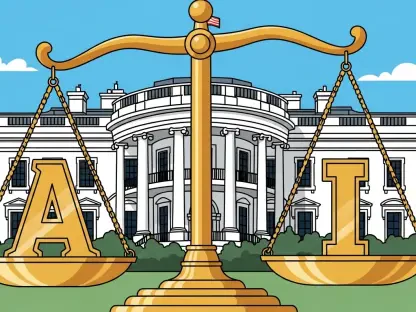Overview of U.S.-EU Trade Relations and Tech Regulation Challenges
Imagine a world where two of the largest economic powerhouses, the United States and the European Union, stand at a crossroads, their trade partnership teetering on the edge due to a clash over digital rules. This scenario is not hypothetical but a pressing reality in 2025, as the transatlantic alliance, which accounts for nearly half of global GDP, faces significant hurdles in finalizing a comprehensive trade agreement. The economic interdependence between these regions is undeniable, with billions in goods and services exchanged annually, yet a critical sticking point has emerged in the form of technology regulations that threaten to derail progress.
At the heart of this discord lies the EU’s stringent approach to governing the digital sphere, which contrasts sharply with the U.S. emphasis on innovation and market freedom. Technology has become a cornerstone of modern trade, influencing everything from data flows to platform operations, and the EU’s regulatory framework is increasingly seen as a barrier by American stakeholders. These policies not only shape how businesses operate across borders but also redefine the parameters of economic collaboration in an era dominated by digital transformation.
Key players in this dynamic include governmental bodies like the European Commission and the U.S. Trade Representative, alongside major tech giants such as Amazon, Google, and TikTok. These companies, often based in the U.S., find themselves navigating a complex web of compliance requirements that impact their global strategies. As negotiations unfold, the interplay between economic ambitions and regulatory priorities continues to shape the trajectory of this vital partnership.
The Core Issue: EU’s Digital Services Act (DSA) as a Trade Barrier
Key Provisions and Goals of the DSA
The EU’s Digital Services Act (DSA), a landmark piece of legislation, stands as a central pillar in the bloc’s mission to safeguard its digital environment. Designed to protect citizens, including vulnerable groups like children, the DSA imposes rigorous guidelines on digital platforms, with a particular focus on very large online providers (VLOPs) that have over 45 million monthly users within the EU. Its primary objective is to ensure accountability, transparency, and safety in the online space by mandating strict content moderation and risk assessment protocols.
For U.S.-based tech giants like Amazon, Google, and TikTok, compliance with the DSA translates into a host of operational challenges. These companies must adapt to detailed reporting requirements, implement robust systems to address illegal content, and face potential fines for non-compliance. Such mandates often require significant investment in infrastructure and personnel, reshaping how these firms operate in one of their largest markets.
The ripple effects of these regulations extend beyond individual companies, influencing broader industry practices. Smaller entities, while subject to lighter obligations, still feel the pressure of an evolving regulatory landscape that prioritizes user protection over unchecked digital expansion. This framework, while commendable in its intent, has become a focal point of contention in transatlantic trade discussions.
U.S. Perspective on Regulatory Constraints
From the U.S. standpoint, the DSA represents a formidable obstacle to innovation and economic growth. American officials argue that the stringent rules impose disproportionate costs on their companies, creating a financial burden that stifles creativity and technological advancement. The perception is that these regulations tilt the competitive landscape, placing U.S. firms at a disadvantage compared to their European counterparts who are more accustomed to such oversight.
Voices from Washington have consistently highlighted the need for a more balanced approach, urging the EU to consider relaxing certain provisions to foster a fairer playing field. The argument centers on the idea that excessive regulation could deter investment and slow the pace of digital progress, ultimately harming consumers on both sides of the Atlantic. U.S. negotiators are pushing for concessions that would ease these constraints as a prerequisite for advancing trade agreements.
This perspective underscores a fundamental divide in how the two regions view the role of regulation in the tech sector. While acknowledging the importance of safety, American stakeholders emphasize the potential of less restrictive policies to drive economic benefits, a viewpoint that continues to fuel heated debates at the negotiating table.
Broader Implications of Regulatory Disparities in Trade Talks
The tension between promoting technological innovation and enforcing strict digital oversight encapsulates a broader challenge in U.S.-EU trade relations. On one hand, innovation fuels economic growth and competitiveness, driving advancements that benefit global markets. On the other hand, robust regulations aim to protect users from the risks of unchecked digital expansion, a priority that the EU holds dear in shaping its policy framework.
Compounding this issue is the reality that non-tariff barriers, such as the DSA, often overshadow traditional tariff discussions in modern trade negotiations. While partial agreements have been reached—such as a reduced 15-percent tariff on EU goods entering the U.S.—these pale in comparison to the complexities introduced by regulatory discrepancies. The focus on digital policies highlights how trade talks have evolved, with technology becoming a linchpin of economic strategy.
This shift reflects the intricate nature of contemporary trade agreements, where data governance and tech standards play as critical a role as physical goods. The growing centrality of these issues complicates negotiations, as both sides grapple with aligning their economic objectives with divergent regulatory philosophies. Resolving these disparities remains a daunting task, yet it is essential for unlocking the full potential of transatlantic commerce.
The Regulatory Landscape: EU’s Commitment to Digital Safety
The EU’s unwavering commitment to digital safety forms the bedrock of its regulatory approach, prioritizing consumer protection above all else. Through frameworks like the DSA, the bloc seeks to create a secure online environment where risks such as misinformation, illegal content, and privacy breaches are minimized. This stance is rooted in a belief that a regulated digital space benefits society by fostering trust and accountability among platform providers.
In stark contrast to U.S. priorities, which often lean toward deregulation to spur innovation, the EU shows little inclination to compromise on its core values for trade gains. European leaders argue that weakening these standards would undermine years of progress in building a safer internet, a position that has been reiterated in numerous policy statements and public forums. This rigidity poses a significant challenge in finding common ground during trade discussions.
Despite this firm stance, there are glimmers of potential for dialogue, as U.S. officials have noted the EU’s willingness to discuss digital trade barriers. However, no concrete commitments to alter existing regulations have been confirmed, leaving room for speculation about whether future talks might yield compromises. The balance between safety and economic collaboration remains a delicate issue, with both sides keenly aware of the stakes involved.
Future Outlook: Navigating Tech Regulation in Trade Agreements
Looking ahead, the path forward for U.S.-EU trade talks hinges on the ability to forge mutual concessions in the realm of digital regulations. Both parties must navigate a landscape where compromise does not equate to abandoning core principles, whether it’s the U.S. push for innovation or the EU’s dedication to safety. Crafting agreements that address these concerns without alienating either side will require innovative diplomacy and a willingness to explore uncharted territory in policy alignment.
Emerging trends in the global tech arena, particularly the rising significance of data policies, are set to further influence international trade dynamics. As data becomes a critical asset in economic exchanges, issues like cross-border data flows and privacy standards will likely take center stage in future negotiations. This evolving focus underscores the need for adaptive frameworks that can accommodate rapid technological advancements while maintaining regulatory integrity.
Several factors will shape the trajectory of these discussions, including the pace of innovation, shifting consumer protection priorities, and overarching global economic conditions. The ability to anticipate and respond to these elements will determine whether a sustainable trade agreement can be reached. As negotiations progress from 2025 onward, the interplay of these variables will remain a critical area of focus for policymakers and industry leaders alike.
Conclusion: Balancing Innovation and Regulation for Trade Progress
Reflecting on the discussions that unfolded, it became evident that EU tech regulations, particularly the Digital Services Act, stand as a formidable barrier to finalizing a U.S. trade agreement. The divergence in perspectives—U.S. frustration with perceived overregulation juxtaposed against the EU’s steadfast commitment to digital safety—paints a complex picture of competing priorities. This impasse highlights the intricate dance between economic aspirations and regulatory imperatives that define the negotiations.
Moving forward, actionable steps emerge as a necessity for breaking the deadlock, with a focus on establishing joint working groups to tackle specific digital policy issues. Exploring pilot programs to test balanced regulatory approaches offers a potential solution, allowing both sides to assess impacts without immediate overhauls. Additionally, prioritizing regular summits dedicated to tech and trade could foster deeper understanding and trust, paving the way for incremental progress.
The journey ahead demands a nuanced strategy, one that embraces flexibility while safeguarding core values on both sides of the Atlantic. By investing in sustained dialogue and innovative policy experiments, stakeholders could chart a course toward a trade framework that harmonizes innovation with regulation. This approach promises not just resolution but a blueprint for future global economic partnerships in an increasingly digital world.









